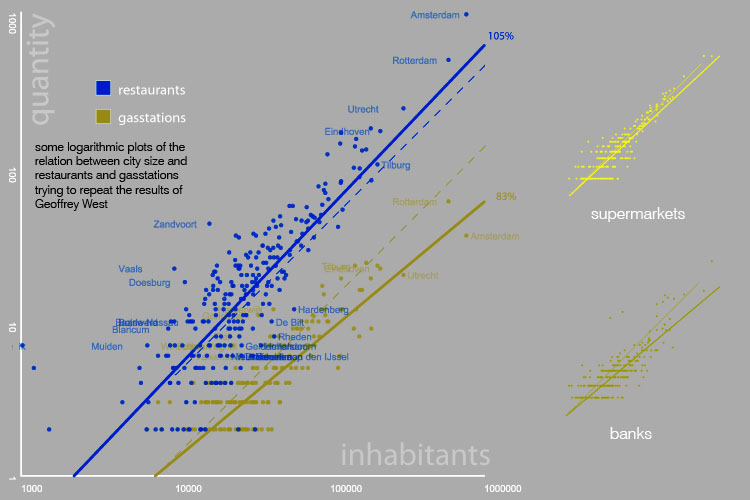-
What does Geoffrey West know about Dutch Cities without visiting?
by Mark van der Net 10 jaren,8 maanden geleden

Geoffrey West, a British theoretical physicist once claimed at a conference that before he started to work on the subject of cities there was no scientific urban theory. Of course the city also deserves a softer qualitative treatment but after so many centuries of urbanism the results of Wests quantitative approach are surprisingly fresh. Maybe urban lovers and haters alike indeed forgot to consider the simple numerical facts?
Wests thesis - put forward in highly accessible lectures like that at TEDTalks and articles in Nature - states that cities follow simple mathematical 'laws'. It turns out that a lot of urban quantities ranging from infrastructure, income, patents, to number of crimes and gas stations are lineaer.
Meaning that if you have double the amount of inhabitants in a city - instead of getting twice as many gas stations for example - one finds 15% less than expected. So bigger cities are more effectively organized. Other properties like income, patents - but also crime - on the other hand show a relative increase of 15%.
So this so called 'super linear scaling' could be the bottom-line why so many people live in cities everywhere. Indeed this 'everywhere' is important. According to West all cities in the world follow these 'universal' rules, with only small variances due to specific differences. This is because cities are inherently (social) networks. Networks that make the potential of the city grow without apparent boundaries.
I put some Dutch data together to try to repeat Wests results; no doubt without his scientific rigour and mathematical ingenuity. Still I could find a lot of the same striking properties.Update 2015: The theories of West and Bettencourt captured the public imagination with presentations (like the TED talk) but only slowly found their way in the academic discourses and especially in the professional urban design field. For me it is still a bit unclear why this is so. Some responses criticized the methods like the rather elaborate philosophical presentation by Ludger Hovestadt that seems somewhat characteristic of complex entanglement between the scientific and artistic within the architectural and urban design profession. A more robust assessment came from Batty and his research group from the University College London which found that population size alone provides insufficient information to describe a state of a city. Also the research found most urban indicators (patents, income) in the UK scale linearly – and not super-linear.

